too much jargon
Yes, let’s all admit it. We probably use jargon more than we should. It’s so ubiquitous that it’s like a second language that you might metaphorically list at the bottom of your resume. Hey, wow, look at me.
Yes, it can be useful
Sure, it has a function. It’s a short-hand way to say something that the other person likely understands. Hint: if you have to explain the jargon, then it’s actually making it harder to communicate.
Check out this nice distinction made by Seth Godin between jargon and lingo:
Jargon is intentionally off-putting, and lingo reminds us how connected we are. They might look similar, but the intent is what matters. Jargon is a place to hide, a chance to show off, a way to disconnect. Lingo, on the other hand, allows us to feel included.
Generally, a bad habit
Too often, jargon is a short-hand way to say boring things in a more pseudo-intellectual way. It is a chummy way to talk. “See, I know what I am talking about. I’m cool.” Are consultants jealous of doctors & lawyers who have their own technical vocabulary? Hope not. . .

After some thought, I grouped this jargon into different buckets depending on how much analysis was needed vs. how much analysis was done. This simple box often called a “two-by-two” matrix and is a favorite among consultants. It narrows down the key factors into the X and Y axis and forces you to group this into something easy to understand.
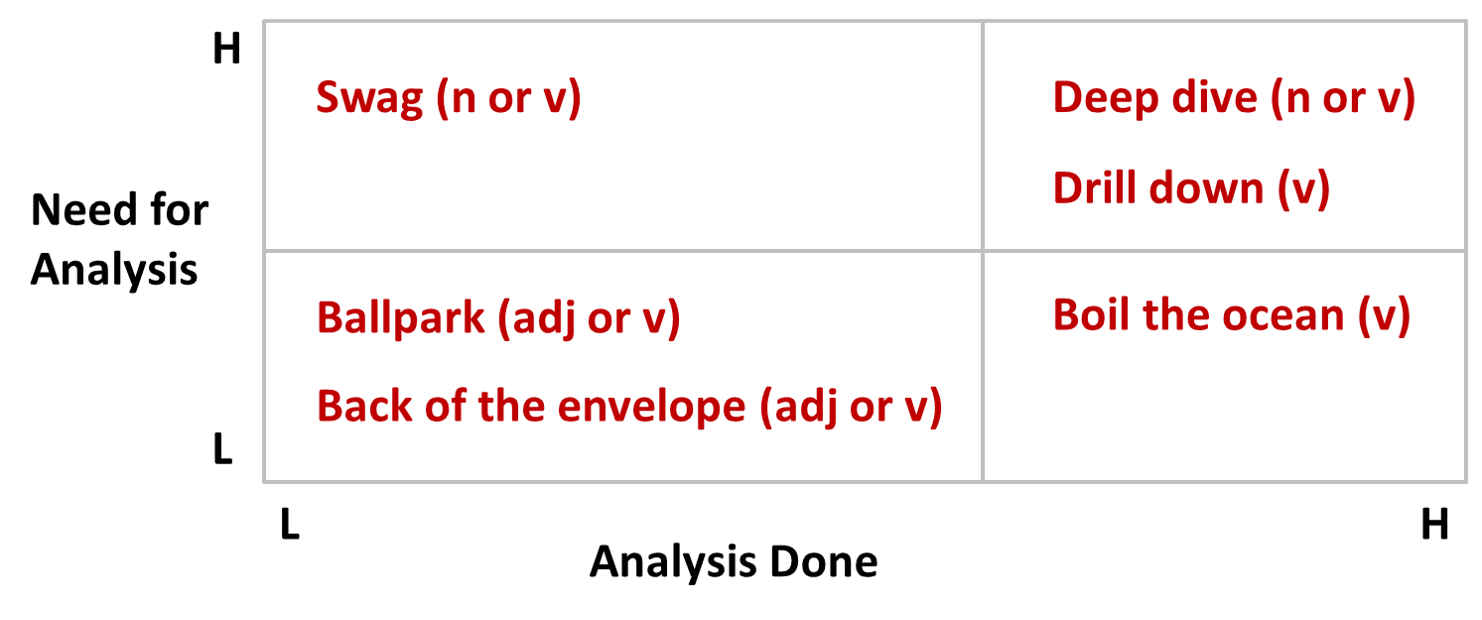
Ballpark or back-of-the-envelope estimate
At the beginning of a project, it is often necessary to just ballpark the number or do a back of the envelope calculation to get some initial estimates. Perhaps the estimates are from research, benchmarking, or just plain experience. When writing a proposal, there is a fair bit of scoping and smart guessing what the answer could be.
NB: Implicit in this discussion of high-level guessing is the idea that more rigor will / can be done later. The demands of accuracy in the analysis is low, and that’s what you get. Low-Low.
Swag
Here the consultant made a mistake. Either they ran out of time, got lazy, or forgot to do the needed analysis. As a result, he is taking a swag at the answer – which is never a good idea. It is a lose-lose. Either the consultant tells the client that he is guessing (lose) or hides the weakness in the analysis (lose).
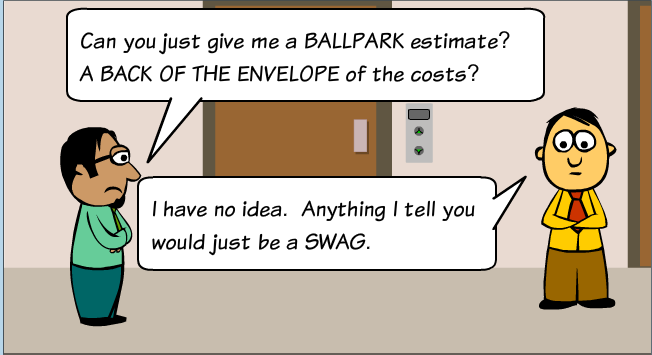
Deep dive, drill down
These two expressions are very common. After completing a broader analysis, it is often necessary to do a deep dive in specific areas. You often have to drill down into the the data to really find out what is going on. Deep dives are good things because they have a lot of rigorous analysis, but they are also very targeted.
For example, you are analyzing spend categories and find that 8 “buckets” of spend drive 80% of the costs. Time for a deep dive analysis which might entail more data sets from the vendors themselves with information on specifications, service levels and other details. The goal is to give the key drivers of the costs.
Boil the ocean
Here the consultant is wasting time. She has spent hours gathering data or doing analysis without a purpose. She is tediously doing work, instead of thinking through the problem in a structured way first. If the partner says you are boiling the ocean, it means that you are lost. Not a good sign.
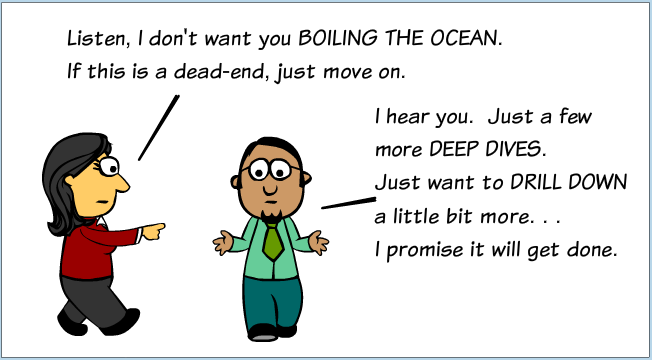

Frankly, all of us spend too much time in meetings – so it is no surprise that there is a lot of jargon around this topic. Thinking through different ways to visualize this, believe a chronology works best. What happens before, during, and after the meeting.
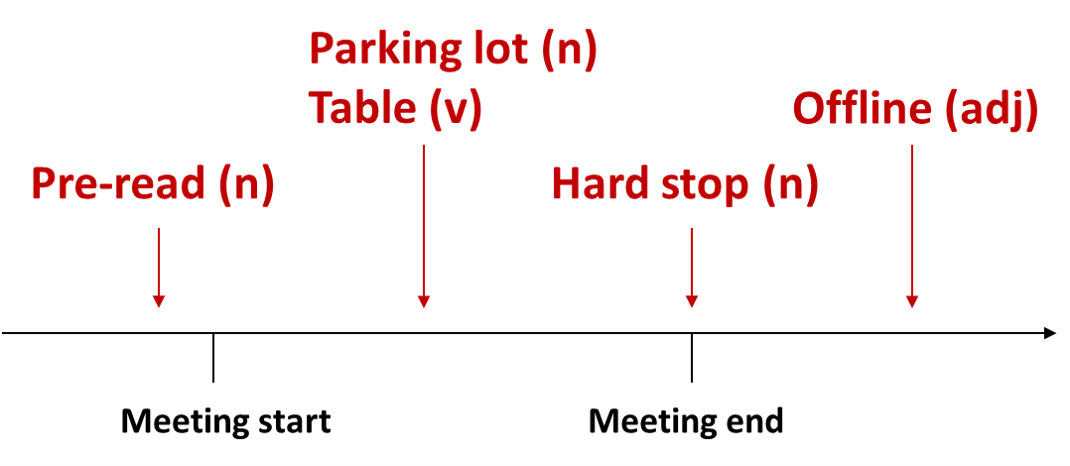
Pre-read
Why not send information to the attendees ahead of time so they know what to expect. Perhaps it’s not your full presentation, but instead just the executive summary? If there is a “lecture” portion of the session where people have to sit quietly and listen (read: boring), why not record it in advance and send to them to PreWatch? That way they can see it in 1.5x speed, listen to it twice, or even watch it on their iPad while on the couch?
put in Parking lot, Table for later
My advice when facilitating a meeting: 1) clearly articulate the meeting scope so everyone knows/agrees on the reason you are there 2) be mindful of the constraints (time, content to cover, key decisions that need to be made) 3) be respectful of the flow of conversation AND limit conversational tangents.
- Key point: don’t let the train jump off the tracks.
- Reality: It’s too easy to have a conversation go off topic for reasons both innocent and ignorant
Have a handy white board where you can make notes of things to be “tabled” or discussed later. It’s a not-so-subtle, but also entirely acceptably way to re-direct the conversation back to the main agenda.
Hard stop
The latest that someone can stay in a meeting. This is a polite way of saying, “I have another obligation at that time, so don’t be offended if leave the meeting or drop off the call”.
Offline
Just a fancy way to say “Later, in private” This is used to table a conversation until after the formal meeting. This also prevents a conversation between 2 people monopolizing the meeting time
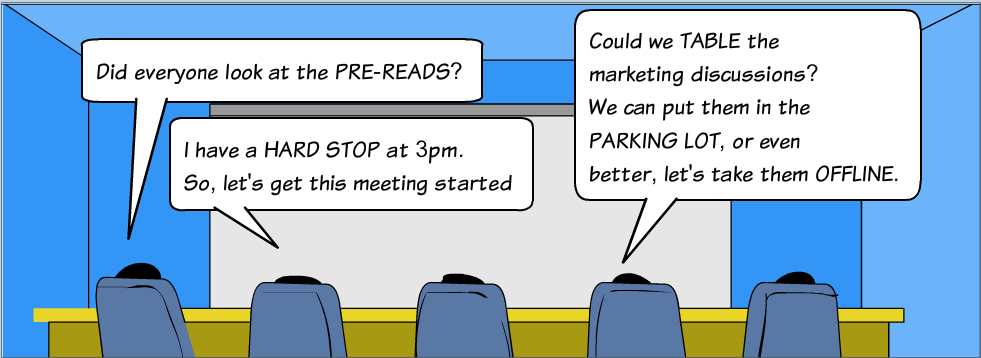
Jargon is endless
There is a website called The Office Life, which has a reservoir to 900+ “cringe-worthy” consulting-y words. If you listen closely, you will see how business jargon is used at your work. It can be overwhelming. Remember: the client wants you to speak clearly and with authenticity, not with business jargon and slang.

Hi,
My name is Jegatheesh Shanmugam and I am taking care of image permissions on behalf of Cengage Learning textbook publishers.
Cengage is currently producing the 10th edition of book “Business Communication: In Person, In Print, Online, 10e”, authored by Newman. Author would like to use the image: “The list of business jargon is endless” in their current edition book.
Please provide your e-mail id to send the forms and documents.
Thanks!
Jega
Consultantsmind1 at gmail